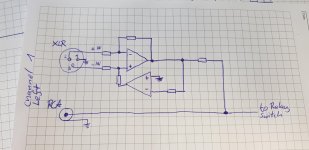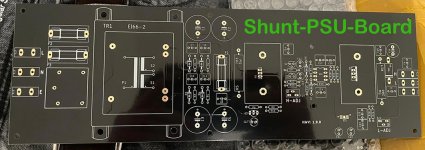In my case single turns were fine. Sensitive, but really fine if you have a steady hand.
I would also advise to play first with the sound variations this little jem offers, so you get the direction.
Mods... the B1 Korg sounds fine as it is and is (of course!) very well designed to start with. So beware, while "everything is admittedly always a compromise", a lot of money could be spent going in the wrong direction or reinventing the wheel. As it is it is excellent value for money.
Having said that, it has some potential for tweaking and the few bits that "could" be done are also dependent on your taste and how far you want to bring this jem. After I built it as recommanded, I decided to spend so money on it and to try some possible tweaks, always with the original as benchmark - some worked, others not really. I reported all MY VERY PERSONAL findings here in depth - use the search function, might these long posts be of some use.
Whatever you dedide to do, you will have a lot of fun!
Claude
I would also advise to play first with the sound variations this little jem offers, so you get the direction.
Mods... the B1 Korg sounds fine as it is and is (of course!) very well designed to start with. So beware, while "everything is admittedly always a compromise", a lot of money could be spent going in the wrong direction or reinventing the wheel. As it is it is excellent value for money.
Having said that, it has some potential for tweaking and the few bits that "could" be done are also dependent on your taste and how far you want to bring this jem. After I built it as recommanded, I decided to spend so money on it and to try some possible tweaks, always with the original as benchmark - some worked, others not really. I reported all MY VERY PERSONAL findings here in depth - use the search function, might these long posts be of some use.
Whatever you dedide to do, you will have a lot of fun!
Claude
Hi Monk55,
I love the Tocos but genuine ones are not always easy to source: stereo versions (I don't know about mono) are now very very difficult to get. There are numerous fakes, who knows what they really are inside...
The picture you showed is from a reputated old shop that to my knowledge stopped ages ago to sell the Tocos. My guess is you purchased it recently, so probably elsewhere and perhaps on a wellknown "bay"?
Regarding your issue, you could indeed first measure the values vs rotation to see if what you have is indeed a log / audio tapper. Tocos did both, fakes could be both... or anything / any 'law". Log is really what you want.
Further, you could compare the backplate of your pot to the pix of mine I posted here. I don't know "for sure" (who does?) if mine are the genuine stuff (they look like it though), nor if originals come now with various backsides, but mine and another unit purchased by a friend in the same "Bay" shop in 2019 sound splendid and have quite a distinctive backplate from "the simple ones" you usualy find... or some that were shown to me and ended up being clear fakes.
Positive is you went Mono and if it is a real Tocos you should enjoy a great sound without any of its single reported possible issue that used to be "channel matching". If it is linear and not log, it can/will be more sensitive to adjustment.
Enjoy music
Claude
I love the Tocos but genuine ones are not always easy to source: stereo versions (I don't know about mono) are now very very difficult to get. There are numerous fakes, who knows what they really are inside...
The picture you showed is from a reputated old shop that to my knowledge stopped ages ago to sell the Tocos. My guess is you purchased it recently, so probably elsewhere and perhaps on a wellknown "bay"?
Regarding your issue, you could indeed first measure the values vs rotation to see if what you have is indeed a log / audio tapper. Tocos did both, fakes could be both... or anything / any 'law". Log is really what you want.
Further, you could compare the backplate of your pot to the pix of mine I posted here. I don't know "for sure" (who does?) if mine are the genuine stuff (they look like it though), nor if originals come now with various backsides, but mine and another unit purchased by a friend in the same "Bay" shop in 2019 sound splendid and have quite a distinctive backplate from "the simple ones" you usualy find... or some that were shown to me and ended up being clear fakes.
Positive is you went Mono and if it is a real Tocos you should enjoy a great sound without any of its single reported possible issue that used to be "channel matching". If it is linear and not log, it can/will be more sensitive to adjustment.
Enjoy music
Claude
I'm just getting back into playing with audio and have ordered the Korg B1 PCB, FETS, and tube from the diyaudio store and the stuffing parts from Digikey.
I would like to ask a couple of questions; I tried to find answers but there are just too many pages to wade through in this thread.
First, I plan to replace the 50K volume control with a 10K LDR volume control (BTFSystems). Will I suffer dire audible consequences by making this switch?
Second, are there any obvious upgrades to the components listed on the BOM that would significantly improve the sound? I imagine the input and output capacitors could be upgraded at considerable expense but I am interested in the biggest bang for the buck, not too far out on the curve where price-performance gets flat.
Third, I cannot find the physical dimensions of the PCB anywhere. Could someone tell me what they are? I'm trying to figure out what size enclosure I need for this board plus the LDR board and IR & rotary encoder control board and input selector relay board.
Any comments appreciated.
Thanks for that suggestion, I've read the PDF and am curious to see what happens to the sound as I tune the bias. One question I had was that it appears that the BOM calls for a single-turn pot but many of the pictures I've seen posted show a multi-turn. Wondering if the adjustment is sensitive enough that I should get some multi-turn pots right away and install in lieu of the single turn. I'm thinking the 4-turn would be enough. Does that sound right?
I've had good luck with the stock kit pot but it is indeed touchy so one with more turns might be easier to get right on the setting you want.
--Tom
I've seen references to the first run of chassis having ventilation slots which added to microphonics problems. Can I assume that current shipments have an unventilated chassis? I ask because the pictures at the diyaudio store are of a chassis with ventilation slots. If it's a real problem I'm thinking the slots would be gone by now.
two-way local selector per each input (choosing either Bal or SE) , then main SE 5way selector, feeding KB1?
yes
If I got you right you mean I need to have a physical switch to select between SE and BAL and so my actual idea would not work?
I made a quick handdrawn schematic for clarification below. Again all the credits for this circuit go to Rod Elliott as linked in the last post.
Attachments
my new nutube preamp
Hello,
my first nutube i built has based on the original board from diy audio shop.
I have also presented the preamp here, with chassis and external power supply.
you can see in posts #4833, #4874 and #4878
The good result has made me think about a new, own construction.
Matched 2sk170 jfets should be used, as well as better capacitors (V-Cap Odam many thanks to chris venhaus for the good advice and the ingenious capacitors, also Black Gate Capacitors), a vibration-optimized installation of the nutube, and an even better power supply, for 24V and 9.1V version as shunt power supply and adjustable. My friend marc then converted my ideas and component specifications into a very nice circuit board. He also planned the shunt power supply for me and designed the boards. thank you for that.
The vibration-technical processing of the nutube has occupied me for a while and I have made several tests and measured the vibrations. I realized the result on a new nutube board with stand off board and a few other things. I present the result and solution here to you. The biggest problem is, that the nutube has too little mass and can be very easily stimulated to swing. the nutube with the stand-off board weights 14,2g. I have the nutube firmly glued to the stand off board. the board is then screwed on 2 corners with m3 rubber dampers to the base board.
to achieve a higher mass of the nutube with the stand-off-board, i glued a piece of brass 1,5x1,5x5,0 cm under the stand-off-board. now the whole unit has a mass of 140g. that's more manageable. I have bent the connecting wires like a coil spring, so that no vibrations are transmitted, but are even more damped.
I have presented the new board with some photos and videos here.
Since i expect this preamp to stay in my system for a longer time, i also thought a bit more about a fine chassis.
the power supply will still come in an external chassis, because i need beside the 24V and 9,1V also a power supply with +/- 15 V for my PCU (preampcontrolunit).
The front of the new nutube is already pre-milled, has to be ground, then bead blasted and then anodized. On the photo you see the front for the nutube and the front for the M2.
Hello,
my first nutube i built has based on the original board from diy audio shop.
I have also presented the preamp here, with chassis and external power supply.
you can see in posts #4833, #4874 and #4878
The good result has made me think about a new, own construction.
Matched 2sk170 jfets should be used, as well as better capacitors (V-Cap Odam many thanks to chris venhaus for the good advice and the ingenious capacitors, also Black Gate Capacitors), a vibration-optimized installation of the nutube, and an even better power supply, for 24V and 9.1V version as shunt power supply and adjustable. My friend marc then converted my ideas and component specifications into a very nice circuit board. He also planned the shunt power supply for me and designed the boards. thank you for that.
The vibration-technical processing of the nutube has occupied me for a while and I have made several tests and measured the vibrations. I realized the result on a new nutube board with stand off board and a few other things. I present the result and solution here to you. The biggest problem is, that the nutube has too little mass and can be very easily stimulated to swing. the nutube with the stand-off board weights 14,2g. I have the nutube firmly glued to the stand off board. the board is then screwed on 2 corners with m3 rubber dampers to the base board.
to achieve a higher mass of the nutube with the stand-off-board, i glued a piece of brass 1,5x1,5x5,0 cm under the stand-off-board. now the whole unit has a mass of 140g. that's more manageable. I have bent the connecting wires like a coil spring, so that no vibrations are transmitted, but are even more damped.
I have presented the new board with some photos and videos here.
Since i expect this preamp to stay in my system for a longer time, i also thought a bit more about a fine chassis.
the power supply will still come in an external chassis, because i need beside the 24V and 9,1V also a power supply with +/- 15 V for my PCU (preampcontrolunit).
The front of the new nutube is already pre-milled, has to be ground, then bead blasted and then anodized. On the photo you see the front for the nutube and the front for the M2.
Attachments
-
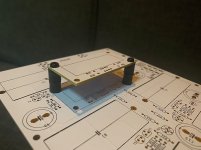 stand_off_2.jpg553.3 KB · Views: 288
stand_off_2.jpg553.3 KB · Views: 288 -
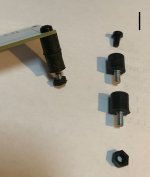 stand_off_1.jpeg373 KB · Views: 284
stand_off_1.jpeg373 KB · Views: 284 -
IMG_9632.mp41.2 MB
-
IMG_9554.mp41.2 MB
-
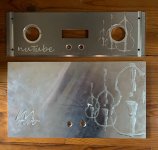 Front.jpg761.1 KB · Views: 302
Front.jpg761.1 KB · Views: 302 -
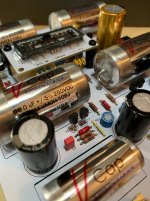 Board_05.jpg647.5 KB · Views: 287
Board_05.jpg647.5 KB · Views: 287 -
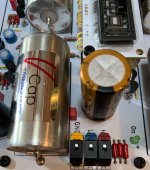 Board_04.jpg673.9 KB · Views: 412
Board_04.jpg673.9 KB · Views: 412 -
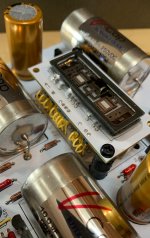 Board_03.jpg519.8 KB · Views: 415
Board_03.jpg519.8 KB · Views: 415 -
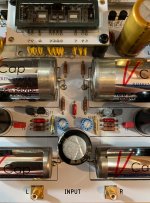 Board_02.jpg640.2 KB · Views: 437
Board_02.jpg640.2 KB · Views: 437 -
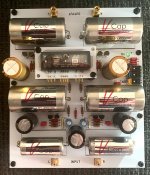 Board_01.jpg868.9 KB · Views: 476
Board_01.jpg868.9 KB · Views: 476
Started my B1 kit today and have a couple of questions....
Working on steps 38-42 in the build guide, my kit contained 2 ublue resistors and one brown but I checked the resistance and it matched the PCB, so I installed them.
I initially installed the 9.1v diode backwards and applied power, I have since reversed it. Now the PSU tests fine with the exception of the diode, which is reading 0, do I need to replace this now since I had reversed it?
Follow-up...went ahead and ordered a new diode, arrived today, installed and tested perfectly. Was able to finish the build this evening and my B1 is working perfectly so far.
I'm waiting for parts to arrive from dyaudio store (delayed by weather), and doing some reading. It looks like microphonics are a problem for some people, and I'm trying to think how to minimize the problem with minimum effort, trying to understand how the vibrations reach the tube.
I gather that it can happen through the air, but the new version of the chassis without ventilation holes pretty much solves that so, the transmission to worry about is physical transmission.
What I'm wondering is this: can the Nutube be supported entirely by its pins soldered to the pcb (which I gather are only on one side of the tube) and, if yes, would it be enough to dampen them where they attach to the tube -- i.e., would a bead of silicone sealer surrounding each pin be adequate for the job? It could be applied and allowed to dry before soldering to the pcb, with perhaps, a small dot or two of sealer somewhere near the other side if needed to support the tube. Sealer stays flexible so should be a good vibration barrier.
Has anyone tried this?
I gather that it can happen through the air, but the new version of the chassis without ventilation holes pretty much solves that so, the transmission to worry about is physical transmission.
What I'm wondering is this: can the Nutube be supported entirely by its pins soldered to the pcb (which I gather are only on one side of the tube) and, if yes, would it be enough to dampen them where they attach to the tube -- i.e., would a bead of silicone sealer surrounding each pin be adequate for the job? It could be applied and allowed to dry before soldering to the pcb, with perhaps, a small dot or two of sealer somewhere near the other side if needed to support the tube. Sealer stays flexible so should be a good vibration barrier.
Has anyone tried this?
Nutube Accessory Kit
I haven't tried what you suggest, but just to add to your list of options, I thought I'd point to the Nutube accessory kit - there's reference to it buried in this thread somewhere, but here it is again.
NUTUBE ACCESSORY KIT 01 | Korg Nutube NUTUBE ACCESSORY KIT 01 | RS Components
I haven't tried what you suggest, but just to add to your list of options, I thought I'd point to the Nutube accessory kit - there's reference to it buried in this thread somewhere, but here it is again.
NUTUBE ACCESSORY KIT 01 | Korg Nutube NUTUBE ACCESSORY KIT 01 | RS Components
I haven't tried what you suggest, but just to add to your list of options, I thought I'd point to the Nutube accessory kit - there's reference to it buried in this thread somewhere, but here it is again.
I didn't know that this option existed. I'm still hoping to keep it as simple as possible.
I just finished my kit yesterday. My nurture came with 2 adhesive squares that I placed between the nurture and the PCB before soldering. I tapped lightly on the case a few times while it was playing and didn’t hear anything. Only been a day though.
- Home
- Amplifiers
- Pass Labs
- B1 with Korg Triode
